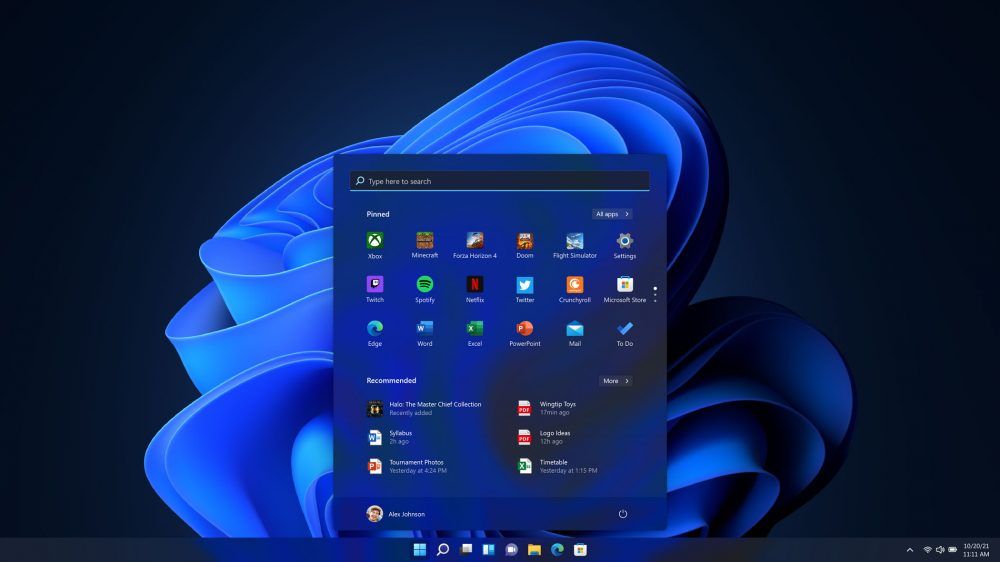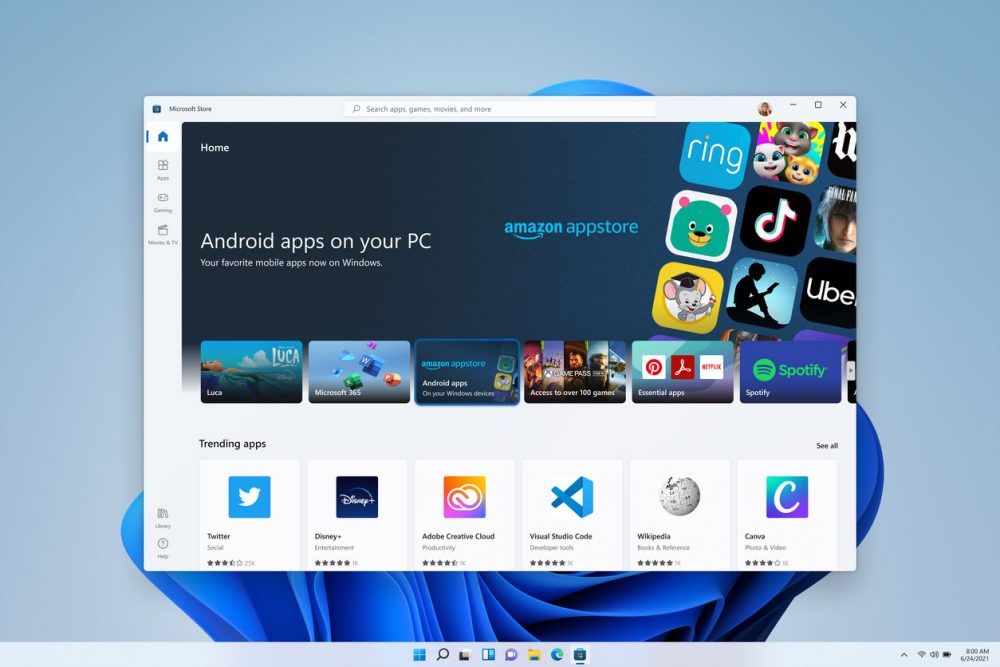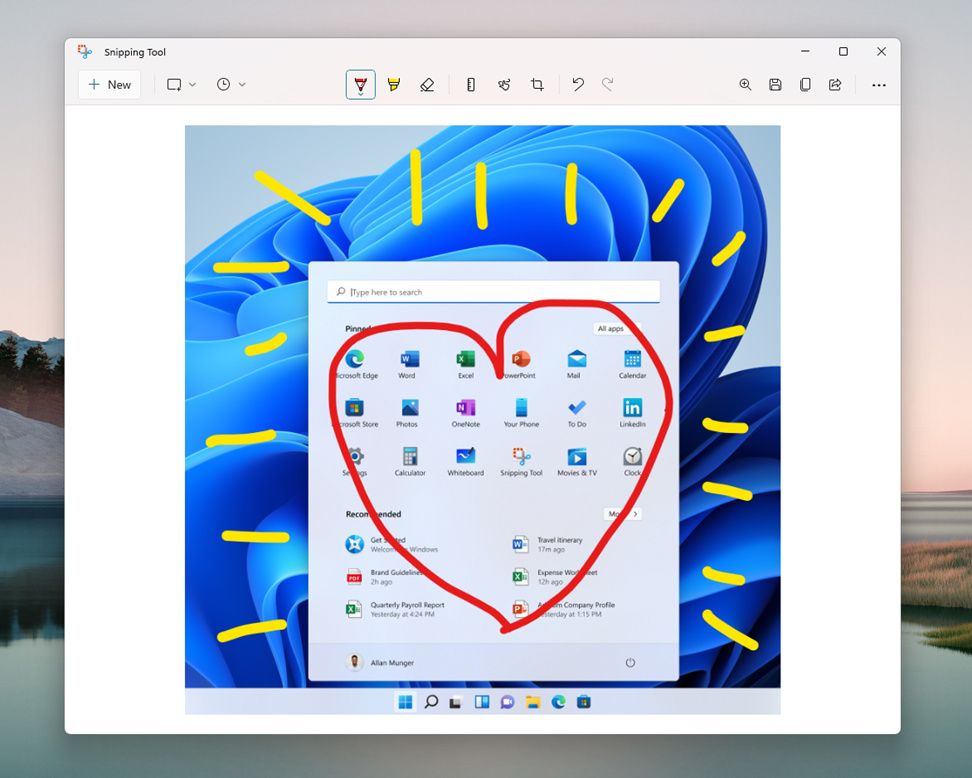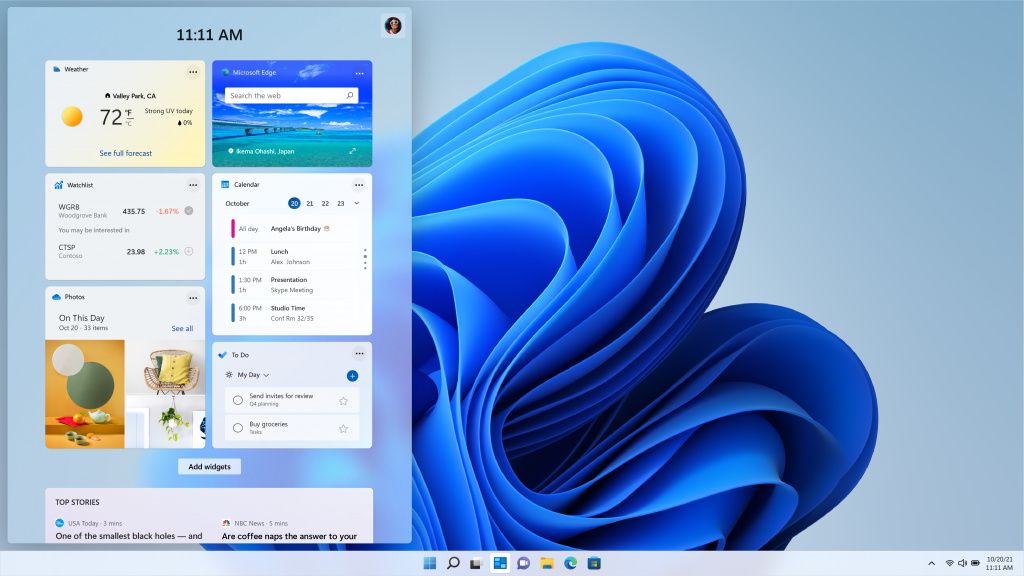After what seemed like ages of waiting, what Microsoft called “the next generation of Windows” is here. Windows 11 is a major, major change. It’s representative of a big shift in how Microsoft delivers Windows, but it’s also a big UX overhaul as well. On top of that, it’s getting Android app support, a new Store, and much more. Here’s everything you need to know.
Navigate this page:
When is Windows 11 release date?
Windows 11 came out on October 5. Microsoft says that newer PCs will get it earlier than older PCs, and the staged rollout will last until mid-2022.

If you haven’t seen it through Windows Update yet, you can still get the final build through the Beta and Release Preview channels of the Windows Insider Program, as long as you have a compatible PC. The Dev channel is already running rs_prerelease builds to test out new features, so be careful with that. If you enroll in the Dev channel, you’ll have to do a clean installation of Windows 11 to roll back. And of course, you can also get it on a bunch of new laptops and desktops like the Surface Laptop Studio and Surface Pro 8.
You’ll need a PC that meets the minimum requirements to be supported on Windows 11. Check out our guide for getting started with Windows 11 here. If you want to try out some workarounds for getting it installed on unsupported PCs, we’ve got a guide for that too. Be careful though. While Microsoft will let you install Windows 11 on an unsupported PC, you’re putting yourself in an unsupported state, while Windows 10 is still supported for another four years.
But wasn’t Windows 10 the last version of Windows?
Back when Windows 10 was announced, it was going to be the last version of Windows. After that, we’d have Windows on a service, and the plan was to let it evolve over time. In fact, I’m sure Terry Myerson knew that there would have to be a big design overhaul at some point, and he thought that would be a Windows 10 update.
Also, to be clear, a developer evangelist named Jerry Nixon was the only one that actually said that Windows 10 was the last version. Microsoft just sort of didn’t correct it, seemingly confirming Nixon’s remarks. Still, this was absolutely Microsoft’s internal mindset at the time.
Here’s the big issue though. Everyone that said Windows 10 would be the last version of Windows doesn’t work there anymore. Panos Panay is in charge of Windows now, and he’s something of a showman.

A good way to think of this is a rebrand, but a rebrand that’s coming at a time where there’s a big UX overhaul. Under the hood, this is the same Windows 10 that we’ve known for years, and it could have shipped as a Windows 10 update. The new brand is about creating excitement around the idea that this is brand-new.
This is not what Windows 10X would have been, because that was only going to arrive on new PCs. Windows 10X was never going to be sold as retail licenses either. With Windows 11, there won’t be any technical reason that you can’t go ahead and install it on any PC.
Microsoft will continue on with Windows as a service, so this will be a free upgrade. But also, don’t expect this to be confirmed as the last version of Windows or anything. We’ll probably get Windows 12 in a few more years. We actually asked how version numbers will work with Windows 11, since it’s going to be updated once a year now instead of twice a year. There’s no need for H1 and H2 anymore. Microsoft wouldn’t comment.
Is Windows 10X dead?
Windows 10X was supposed to be the real next generation of Windows. Along with a complete visual overhaul, it had a lot of under-the-hood changes like running all apps in containers. Microsoft recently announced that it’s dead, and a lot of its features are being folded into Windows 11.

Windows 10X Start Menu
While it had been rumored long before that as Windows Lite, Windows 10X was actually unveiled alongside Microsoft’s Surface Neo as a dual-screen OS. It eventually abandoned its dual-screen ambitions, promising to deliver it on single-screen devices, like cheap laptops. Panos Panay actually wrote in a blog post that he wanted to meet customers where they’re at, even though you’d have to buy a new PC to get it.
Things pretty much fell apart from there. There were some Windows 10X emulators that came out when Microsoft has big plans, but when the single-screen build leaked, it couldn’t even run Win32 apps anymore. Instead, we’re getting Windows 11, which will have the UX elements from Windows 10X.
Can my PC run Windows 11? Is it a free update?
Windows 11 is a free update for Windows 10 users, and that’s not meant to be temporary like the original Windows 10 upgrade was. Unfortunately, the system requirements are higher for Windows 11. There’s no more 32-bit support, and older CPUs won’t be supported. You also need at least 4GB RAM and 64GB storage. The biggest roadblock for many seems to be the requirement of TPM 2.0.
Here’s the list:
| Processor: |
1 gigahertz (GHz) or faster with 2 or more cores on a compatible 64-bit processor or System on a Chip (SoC) |
| RAM: |
4 gigabyte (GB) |
| Storage: |
64 GB or larger storage device
Note: See below under “More information on storage space to keep Windows 11 up-to-date” for more details.
|
| System firmware: |
UEFI, Secure Boot capable |
| TPM: |
Trusted Platform Module (TPM) version 2.0 |
| Graphics card: |
Compatible with DirectX 12 or later with WDDM 2.0 driver |
| Display: |
High definition (720p) display that is greater than 9” diagonally, 8 bits per color channel |
| Internet connection and Microsoft accounts: |
Windows 11 Home edition requires internet connectivity and a Microsoft account to complete device setup on first use.
Switching a device out of Windows 11 Home in S mode also requires internet connectivity. Learn more about S mode here.
For all Windows 11 editions, internet access is required to perform updates and to download and take advantage of some features. A Microsoft account is required for some features.
|
Microsoft also changed the CPU requirements. Seventh-gen and older Intel CPUs are out; well, kind of. The Redmond firm promises early on that it was going to reconsider seventh-gen Intel CPUs and AMD Zen 1 processors. It ended up deciding that AMD Zen 1 totally wasn’t happening, and on the Intel side of things, the vast majority of seventh-gen chips are still unsupported. For seventh-gen, it ended up adding X-series processors, Xeon processors, and the Core i7-7820HQ to the list. The Core i7 just happens to be the one that’s in the Surface Studio 2.
The company is also going to let you install Windows 11 on unsupported hardware if you use an ISO. However, you might not receive updates after that, as you’ll be considered to be in an unsupported state.
Is Microsoft going to force me to upgrade to Windows 11?
The short answer is no, Microsoft isn’t going to force anyone to upgrade to Windows 11. Starting with Windows 10 version 1903, the Redmond firm stopped forcing people to install feature updates. This came after a disastrous Windows 10 version 1809 that actually deleted some users’ files.

It uses its newer ‘seeker’ method. When you check for updates in Windows Update, it simply tells you that a feature update is available if you want it, and you can opt into taking it. The only time Microsoft forces a Windows 10 feature update is if the one you’re on is nearing the end of support, but that’s not even going to happen with Windows 11.
Windows 11 is available as a free update to seekers now. If you don’t want it, there’s actually going to be a new Windows 10 update as well, called version 21H2. Microsoft wouldn’t commit to whether or not version 21H2 will be the last Windows 10 update, but it’s definitely going to support the OS until 2025, so if you don’t want Windows 11, you’re good to go for a while.
What’s new in Windows 11? Is this the Sun Valley update?
You might have heard the term Sun Valley tossed around for the last few months before Windows 11 was announced. That’s the codename for the big UX overhaul that’s available with Windows 11. It’s meant to make the OS more touch-friendly, something that Windows 10 has struggled with.
Here’s everything that we know is coming:
Android apps
Android app support is the one announced feature that didn’t make it into the product at launch. It should still arrive for Insiders by the end of the year.
The rumors of Project Latte were true. You’re going to be able to run Android apps in Windows 11. You’ll be able to get them through the Microsoft Store too, but notably, Microsoft has partnered up with Amazon to bring the Amazon Appstore to the Microsoft Store. That means that yes, there will finally be a touch-friendly Kindle app coming to Windows.

The company mentioned that Amazon was the company that it partnered with, but the Appstore isn’t the only place you’ll be able to get Android apps from. In fact, Microsoft said it wants to be able to run all Android apps one day, including those that require Google services. Note that it’s just a goal to support all Android apps, not a commitment.
A big visual overhaul, with rounded corners
Windows 11 is visually different from Windows 10. Because as Windows 10 has had some subtle changes to the design over the years, it hasn’t gotten a whole new look, like the kind of new look we typically get from a new version of Windows.
And yes, there are rounded corners. Windows has been focused on sharp corners ever since Windows 8, and those squared-off tiles made their way into Windows 10 as well. Windows 11 will follow suit with more modern operating systems like iOS and Android now.

There’s a brand-new Start Menu, which is centered and floating. In fact, it’s just like Windows 10X was. The taskbar is centered as well.
There are also new, more colorful icons throughout the operating system. You’ll find these in the more modern File Explorer, Device Manager, and pretty much anywhere else. These are available in Windows 10 previews, and they make for a pretty big visual change on their own.
It’s not just about a new look though. The way you interact with the UI will be different as well. A big focus here is making Windows better for touch, something that Windows 10 has struggled with. Indeed, while Windows 8 was all-in on touch, Windows 10 felt like it scaled back a bit too much. Windows 11 will support more swipe gestures and such, but more importantly, it should be more consistent with what happens when you tap on something.
The touch gestures are the same as when you’re using a Precision touchpad. That way, you’ll be using gestures that you’re already familiar with.
An updated Calculator app
Microsoft is updating inbox apps to include Windows 11 visuals. That means that it’s adding a whole bunch of rounded corners to things like Calculator.

It also includes things like programmer mode, graphing mode, and support for over 100 units and currencies.
Clock with Focus Sessions
Microsoft is introducing a new feature called Focus Sessions with the Clock app in Windows 11. It’s pretty neat. They’re basically scheduled sessions to help you stay focused on a certain task for a certain period of time.

There are several pieces to this feature. You can set a timer for your Focus Session, and you can even link your Spotify for background music. It also integrated with Microsoft To Do, allowing you to sync up with with the tasks that you have scheduled.
There’s also a daily progress dashboard, and a bunch of options to let you customize your Focus Sessions however you need them.
Gaming improvements
Microsoft is laser-focused on gaming, and why shouldn’t it be? It has the only viable PC gaming platform, a console play, and a cloud back end that’s second to none. And as we know, if there’s an Azure play to be made, Microsoft is going to make it.

Windows 11 has a bunch of gaming improvements. One of them is Auto HDR, a feature first included in Xbox Series X|S consoles, and now coming to Windows. It automatically adds HDR to older games, as you can probably guess from the name.
Another feature being borrowed from the firm’s latest consoles is DirectStorage. You’ll need a “DirectStorage Optimized” PC for this one, as you’ll need the kind of SSD that was engineered as part of the Xbox Velocity Architecture, but it’s going to allow for super-fast loading times and better performance.
Finally, Xbox Cloud Gaming is going to be built-in. It’s going to be part of the Xbox app on Windows 11, although to be clear, there’s no reason that that app update shouldn’t come to Windows 10 as well. We’ll have to wait and see if Windows 10 users get the feature.
A new Microsoft Store
One thing that Satya Nadella said at the Build keynote is that the new OS will “unlock greater economic opportunity for developers and creators”. That leads us to a new Microsoft Store. Make no mistake; this is a big part of the update.
Desktop apps still haven’t made it to the Store in the same way that Microsoft would have liked. With Windows 11, there are some big changes. Developers will be able to submit their apps without packaging them, and they can also host them on their own CDN, meaning that they won’t actually have to be distributed by Microsoft, just through the Microsoft storefront.

This is opening up the Microsoft Store in a big way. Previously, big-time apps like Google Chrome were left out because of Microsoft’s own rules. Now, it’s a whole lot easier to put your app in the Store. Speaking of web browsers, developers will no longer have to use the platform engine. Any browser can now be distributed through the Microsoft Store.
The big point is that Microsoft doesn’t care what kind of app you made. It can be Win32, .NET, UWP, Xamarin, Election, React Native, Java, a PWA, or something else, and Microsoft wants it in the store.
Microsoft announced that Adobe Creative Cloud, Disney+, TikTok, and Zoom are all coming to the Store. Moreover, it’s bringing Microsoft Teams and even Visual Studio to its virtual storefront. That’s a big deal, especially Visual Studio.
The company also just wants to make a better store. It’s adding collections to help you to find more apps, and there’s a “pop-up store” that will manage installations when you try to install apps that come from the web.
Not only that, but developers can use their own commerce platforms. That means that your app can use the platform that earns you the most money, and your app can still be in the Store. That includes other app stores too. One of those examples is the Amazon Appstore, which is delivering Android apps. But the Epic Games Store is also in the Microsoft Store now.
A beautiful new Photos app
Microsoft is introducing an all-new Photos app to the OS, which uses the new Mica material and of course, has rounded corners. There are also theme-specific color palettes and new typography.

There’s also a new toolbar for basic photo editing, but more notable is a “filmstrip” that appears across the bottom. This lets you easily scroll through the other images in your album or library. Also, as you can see above, there’s a multi-view option where you can see more than one image at once.
Snap Layouts and Snap Groups
Windows 10 brought us Snap Assist, and Windows 11 is bringing us Snap Layouts and Snap Groups. This is a cool one. In Windows 11, you can hover over the maximize button, and you’ll be presented with layout options.

You can select one of the tiles in the layouts, and your app will snap to that position on the screen. Snap Assist will help you fill in the rest.
While this is useful for everyone, it should be particularly useful for those that use ultra-wide monitors. Microsoft has never supported three apps side-by-side before.
Snap Groups keeps your snapped windows stored. In other words, if you minimize all of your windows and then hover over the app in the taskbar, you’ll see an option to put all snapped apps back in their positions.
You might recall that with Windows 10, Microsoft spent a lot of time trying to revamp old apps. It had a plan to replace Paint with Paint 3D, it did replace Internet Explorer with Edge, the OneNote saga still isn’t over, and Snipping Tool was replaced by Snip and Sketch. As it did with Paint 3D, this approach is getting rolled back with Snipping Tool. Instead of replacing Snipping Tool with Snip and Sketch, it’s just going to replace both of them with a new Snipping Tool.

The product is a lot like if you combined the classic Snipping Tool and Snip and Sketch into one redesigned UWP app. You have options like Rectangular Snip, Freeform Snip, Window Snip, and Fullscreen Snip, and you can use the Win + Shift + S shortcut to get started. After that, it also provides editing tools so you can mark them up and more. And of course, it has dark theme support.
Teams integration
Microsoft is integrating Teams into the OS. You’ll now find Teams Chat right in the taskbar, so you can easily talk to friends. It’s also going to work with SMS, just in case those friends haven’t downloaded Teams yet. The company specifically referred to it as “two-way SMS”, so don’t expect MMS group texts to work.

There’s also a mute/unmute button that’s going to show up in the taskbar, along with an option to start presenting.
Virtual Desktop wallpaper
This is a pretty small change, but if you’re a virtual desktop user, it’s probably a big one. You can set the wallpaper on each of your virtual desktops now, helping you to define the look of each one that might have its own purpose.

Microsoft is adding a widgets panel, which will slide in from the left. The company seems to like to compare it to a pane of glass sliding out. There are plenty of widgets available from apps like OneDrive, Microsoft To Do, and more, but they’re all first-party. Third-party widgets will be available at some point, but the company is being tight-lipped about it.
Windows on ARM improvements
You remember Windows on ARM, right? Windows 10 devices with ARM processors have struggled with a lack of apps, since they’ve only supported 32-bit emulation. With Windows 11, those devices will finally get support for 64-bit app emulation. This is something that’s been in testing with Insiders for a while.
Another thing that’s finally shipping is Hyper-V for Windows on ARM. This actually has been in testing with Insiders since February 2020. Unfortunately, do to various delays with Windows 10X and everything else, Windows 10 has only received enablement package updates since then.
The post Windows 11: Release date, price, and everything that’s new appeared first on xda-developers.
from xda-developers https://ift.tt/3fTr6qY
via
IFTTT












































